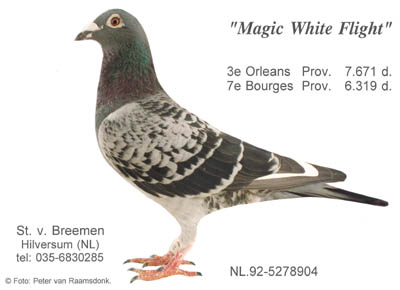Part 15
The respiratory examination

For years I conducted a respiratory examination before basking and I always registered the results. I usually did this in the following manner: one hangs a clock with seconds registration at eye level in the loft and look simultaneously at the clock and at the pigeon. Following this we wait till the pigeon in hand has quieted down, relaxes and has a normal breathing rhythm. We then count the breathing of the pigeon which can best be noticed form the movements of the uttermost back part of the breastbone comb. In general we count 15 seconds, multiply the result by four and obtain the number per minute. I have this time period of 15 seconds also divided in 3 smaller parts of 5 seconds and look to see if three smaller parts were regular or not. In the event the breathing in the first part was faster than in the last, the pigeon in the hand was not yet sufficiently enough quieted down. In that case I simply counted the breathing of more shorter periods and arrived at a conclusion.

"Magic White Flight" scored in 1994 two times in the top ten in National Dayraces. His father is a direct son of "De Bonte Jaarling"(out of "De Goede Jaarling") and "Het Asgrauw" out of the golden pair "De Goede Jaarling" and "Het Schoon Blauw". He is halfbrother to "Riis" 1th National Orleans '96 with 9 minutes ahead in a field of 50.000 birds and a full brother to the hen to produce the 1th National Orleans '97 of Jan Witteveen of Hilversum. Inbreeding on breeding qualities is a guarantee for passing-on power!
I have generally come to the conclusion that the breathing of pigeons with a worn-out organism, or weak pigeons quickly follow each other. They breathe often, short and in rapid succession. In certain cases 70 to 130 breathes per minute can happen. Completely healthy non worn pigeons breathe between 30 and 50 times per minute in my opinion. However I can certainly not declare that pigeons with slower breathing were definitely better flyers than those with higher breathing counts. But I have established that specimen with extraordinary high breathing gave youngsters with normal respiration. The respiration examination has only orientation value and makes sense when it shows, coupled with the examination of the windpipe, which of our pigeons recently were tasked with a heavy load so that is not worth our while to let them participate in competition races ever again. It is therefore an added dimension in the observation process of a pigeon. When we weigh together the most important factors of the performance capacity; the vitality, the muscle quality, the eyes, the facial expression, we can with this help, with sufficient practice almost surely pick the best. Also when you are in a strange loft. And also to help separate the good from the average. As I already wrote, one suppresses this technique in diverse countries on account of a purely egotistical background.
Because one can only realize a successful breeding through competent know-how, I have been busy detailing these important main properties for a long time.
In my entire presentation I have always pointed out that one never may evaluate a pigeon too quickly and on the basis of one single character trait. One may not evaluate her to heaven due to a beautiful eye or good muscles, but neither as worthless on account of one fault. A pigeon's quality is determined by the sum total of the properties. Within this parameter some characteristics become extra important. Others will be less favorable and the final result depends on to what extent the plus points can wipe out the minuses or replace. The difference between expertise of a good pigeon inspector and that of other amateurs can be found that the former can much better and quicker evaluate and consider the balancing properties before he expresses a definite opinion. I must further mention that it is possible to form a certain picture of the performance and other capacities with about 80% of the two year olds and older. However one can often very much err with younger pigeons. As I remarked already the face discloses the greatest part of a pigeon's quality. The face of an inexperienced young pigeon doesn't tell us very much yet. The evaluation of the quality is made significantly more difficult by this and that is even more applicable to young pigeons.
Steven van Breemen
Copyright 1998. All rights reserved. Reproduction in whole, in part, in any form or medium, without the express written permission of Steven van Breemen, is forbidden.
The whole book can be downloaded from "Winning Magazine" if you are a subscriber. You can subscribe here; costs 35 Euro for 1 year. You get 26 issues and have access to the archives with all previous published issues plus next to "The Art of Breeding" a second book written by me: "Hints for Mating, Breeding & Selection". A total bargain!
| 
